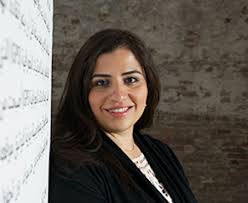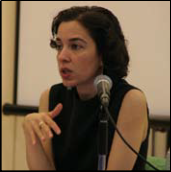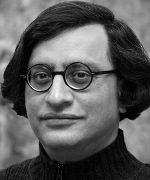“REMAPPING HISTORIES & EXPANDING TERRITORIES” March 7 2015- THE ARMORY ART SHOW CONFERENCE ON THE MIDDLE EAST, NORTH AFRICA, AND THE MEDITERRANEAN (MENAM)- NY March7-8, 2015, NY
Is there only one story of modern art? Is it not fair to accept that with our very present and variegate globality, there could in fact be multiple stories and narratives within the story of such a monicker as the modern – multiple modernities, that at the least might expand on such a term.[1] The issue of diversity and difference as a placing of Others[2] into a larger story of the History of the modern has become not just a fashionable debate about difference and redressing past revisionist histories of one universally accepted modernity, but has also become a present reality of presenting “forgotten” artists, which is starting to see the true light of day. The days of just citing the Matisses, the Pollocks, , the de Koonings, the Gauguins and other Euro- descendant artists as having exclusive right to being and making up the modern (the story of the history of modern art) are finally being concretely discussed and challenged in new and fresh ways; actual results are presently on display, to show a larger screenshot of what actually constitutes a global notion of the modern. The Guggenheim’s latest show of the Iranian painter Monir Shahroudy Farmanfarmaian (born. Qazvin, Iran, 1924) may be an exciting step in the right direction.[3] http://www.guggenheim.org/new-york/exhibitions/on-view/monir-shahroudy-farmanfarmaian-infinite-possibility-mirror-works-and-drawings-1974-2014/installation-photos
The 91 year old Farmanfarmaian’s own words in the recent NY Times article on her exhibition highlight a “forgotten” moment of her own insertion into/ other stories within modern art history, speaking of her multivariate life in the 1940s NY Art scene as an “exotic” young Iranian painter, dancing with Martha Graham and hobnobbing around the likes of Pollock, de Kooning, and Warhol. She went onto to create an extremely important body of work within modernism, mixing Western geometric abstraction with techniques of Iranian cut glass mosaic.
A recent conference was held during The Armory Art Show-featuring incisive and serious talk on “Other” territories of artistic production, “other sides” of modernity, and modernisms/postmodernisms’s many other stories. With Omar Kholeif commissioned as curator for this event, the symposium named The Way Things Can Go, according to its programme,
“draws our attention to apparatuses that shape the discourse, economy, and culture surrounding contemporary art in the Middle East, North Africa, and the Mediterranean (MENAM). Imagined as a multimodal map, The Way Things Can Go, works its way across a broad geographic region, centering on diverse institutions, projects, producers, artistic practices, and narratives that highlight the network that makes up this region’s current cultural and economic infrastructure.”
Re-imagining what are popularly held as the geographical borders of the “middle east”, Kholeif re-imagined “this multimodal map” which also included the Mediterranean in looking at all the present “popular attention given” to art from these regions. By including the Mediterranean, a map of flows was permitted to breathe in real histories that have circulated between these territories and not just “said” borders as defined by past colonial decrees and phantasmagoria.
As was highlighted in the session, “Remapping Histories, Expanding Territories”, this region in question has had a significant history of cultural exchanges and “metissage” [4] through British colonialism, Iraqi Shiite pilgrimages, pan- islamic movements, and artistic exchanges to name but a few of the conduits of transnationalism in these locales. In this session, there was talk of “an expansive horizon…emergent relations and new maps of contemporary art” in this “region”. Iftikhar Dadi, Visiting Scholar at Brown University, spoke about the artist Imran Qureshi (born 1972, Pakistan) as an example of a South Asian artist at those crossroads of “metissage” in this (MENAM[5]) “region”. Dadi also spoke of an extremely interesting artist collective from Mumbai called CAMP http://studio.camp, run by the Indian artist Shaina Anand and Japanese artist Ashok Sukumaran. Their 2009- 2012 production, “Boat Modes” , shown at dOCUMENTA (13) (2012)[6] involved extensive documentation of maritime life on ships and in ports between UAE, Southern Iran, India, and Somalia. Documenting other stories beyond those covered by mainstream media of ex pats fleeing UAE after the bursting economic bubble of 2009, “These sailors[7]described a relationship with Dubai and Sharjah that is longer and more colorful that the land-based history of expatriate labor and construction booms in the UAE. It included riding the monsoon winds to Zanzibar, ferrying dates from Basra during and after wars in Iraq, becoming a medium for India’s “pirate modernity” of smuggled electronics and daily goods, and today, passing through Somali piracy on a daily basis.” [8]These stories were presented by CAMP through “photos, texts, film based on mobile phone videos made by sailor”. CAMP’s work served as a concrete example of a fertile artistic and phenomenological crossroads, and “urge to rethink a region”.
In the session “Remapping Histories, Expanding Territories”, there was also talk of the “coming from within its community”, “how artists work and migrate”, “important to decolonize what this region looks like”, “trans-regionalism” – all phrasal markers of a transnationality in the spotlight, in a sort of renascence of being (re)considered. After a question regarding regionalism by the curator of the conference Omar Kholeif, the panelists added the very important phrasal markers of “moving beyond a regionalism and the regional show”. Shiva Balaghi, Visiting Scholar at Brown University, brought up the ever important challenge of “how to build collection and how not to confine”, “not always comparing to Europe not always comparing us to America”. Iftikhar Dadi added the time-told suggestion that “a good concept enables new ways of thinking”.
It was the Associate Curator from the Guggenheim, Reem Fadda, who had early in the sesison spoke of Fahrelnissa Zeida http://en.wikipedia.org/wiki/Princess_Fahrelnissa_Zeid and her creating a “language not about essentialism[9]”, that left quite an impression. Fadda spoke about reintroducing historical figures from these region’s “own” modernist pasts into having shows in the West’s museum world. She mentioned “reparative measures of art historical measure within museums in addressing these depths in historical narratives” like the Tate’s efforts in presenting their show A Visionary Modernist about the Sudanese painter Ibrahim El Salahi http://www.tate.org.uk/whats-on/tate-modern/exhibition/ibrahim-el-salahi-visionary-modernist and the Lebanese artist Saloua Raouda Choucair http://www.tate.org.uk/whats-on/tate-modern/exhibition/saloua-raouda-choucair. She also also mentioned the spectacular work of VS Gaitonde, recently shown at the Guggenheim http://www.guggenheim.org/new-york/exhibitions/past/exhibit/6298.[10]. Fadda also mentioned the Korean Japanese Lee Ufan “who got the entire rotunda of the Guggenheim”, “as excellent case studies”.
Shiva Balaghi, urgently added to Miss Fadda’s comments regarding “reparative measures of art historical measure within museums in addressing these depths in historical narratives” and of work from these region’s own modernist pasts
“we sometimes assume we are introducing art from this region into the canon and that this is a new development… there is a certain amount of art historical erasure perhaps…so for example if you look at MOMA’s collection, MOMA’s collection when it is being built by the…canon…they bought contemporary modern art from the Middle East but they kept it in storage. I call it closeted modernism…They did not show it. And when they hung those canonical gallery spaces that help defined what modern art is or what modernism is, they did not take out art from this region.They have recognized art being made in this region but there has been a resistance to integrating it into the mainstream narratives.”
Shiva Balaghi also added, recognizing the importance of the Guggenheim’s efforts
“while we talk about the regional, I think it is important to do it in a way and that is why I appreciate the curatorial efforts of the Guggenheim… to do it in way that creates conversations that brings back the art historical narratives that had been erased and doesn’t perpetuate marginalization. Because marginalization has market implications. A work of art that you buy at Armory if it is known as an Iranian work of art or Arab work of art vs being a kind of mainstream Western work of Art, that has price implications…it has implications in terms of whether museums are Balaghi also made it clear that the way of labeling these works of art also has implications for collectors. Again as she said, “ Because marginalization has market implications. A work of art that you buy at Armory if it is known as an Iranian work of art or Arab work of art vs being a kind of mainstream Western work of Art, that has price implications.” Balaghi added that we must find “a way that enables the region”. Reem Fadda added “ that it was important to realize that artists like Fahrelnissa Zeid, is substantiated by the Middle Eastern and other markets but not entered into the North American/ Western sphere of markets. She noted that Fahrelnissa Zeid getting close to 4 million dollars, per painting in auction results (in the Middle East) because of where she stands historically, and this is something we need to keep insisting on, how we value these art works and represent them.”
Iftikhar Dadi then spoke of the importance of continuing to “exert pressure” on an extremely partial picture of modernism.
All this to say, that the panelists were demonstrating the resistance and the recent slow fruition to bringing many of these Other foundational artists of modernity into the mainstream story of what art history is.
This panel was an extremely informative, passionate, and urgent discussion of the contemporary art world, the various “provocative spaces to open dialogue, and the wellspring of inflections that define the “infinite possibilities”, to use the title of the Guggenheim’s show of Monir Shahroudy Farmanfarmaian’s. The “infinite possibilites” that lie within horizons of the art world, once that larger dialogue about modernity becomes a constant marker of our contemporary moment.
[1] “Multiple modernities”, as cited in The Armory Show’s Show Guide and Programming
[2] The Trinidadian philosopher, CLR James faithfully referred to the active participle of the such as “placing ourselves in history”.
[3] Farmanfarmaian’s recent talk with Frank Stella can also be a good sign although I did not attend the talk.
[4] Here is an exciting video elaboration of this term by my mentor Edouard Glissant: http://www.edouardglissant.fr/metissage.html
[5] Middle East, North Africa, and the Mediterranean (MENAM)
[6] Co-commissioned by dOCUMENTA (13) and Sharjah Art Foundation (SAF)
[7] Gujarati Indian sailors we met on the creeks in 2009 are descended from seafaring communities stretching back hundreds of years.
[8] Interview in http://universes-in-universe.org/eng/magazine/articles/2012/camp_documenta
[9] Essentialism – The view that racial groups possess underlying essences that represent deep-rooted, unalterable traits and abilities — and creativity. Source http://www.psychologicalscience.org/index.php/news/releases/racial-essentialism-reduces-creative-thinking-by-making-people-more-closed-minded.html
[10] As the Guggenheim’s introductory page on the exhibition says, “Departing from Klee, Gaitonde’s practice began in the late 1950s in a nonrepresentational mode—or, as he preferred to call it, a nonobjective style. This turn towards abstraction is in accordance with the artistic principles first espoused by Vasily Kandinsky, as is embodied by the Guggenheim’s origins as the Museum of Non-Objective Painting, and also dovetails with Gaitonde’s lifelong interest in Zen Buddhism. It is also important to notice that Fadda noted that most of these artists given full-scale exhibitions and or retrospectives were “artists yet burgeoning on the market”.











